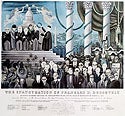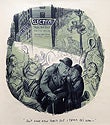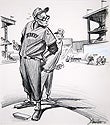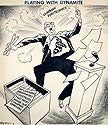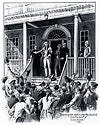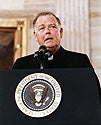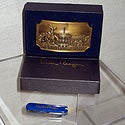Harper’s Weekly news magazine, begun in 1857 and having 200,000 subscribers by 1860, was a key source of information about news events in nineteenth-century America. Illustrations were an important part of the Weekly’s content, and it developed a reputation for employing some of the most renowned illustrators of the time. A contemporary and rival publication, Frank Leslie’s Illustrated Weekly, was in circulation from 1852-1922, and employed several of the same artists as Harper’s. Pathways to the Presidency includes beautifully framed, hand-colored illustrations from the pages of these magazines, which were the generous donation of Wesley C. Pickard and Jeanette A. Studley.
The six political cartoons displayed are part of the Fair Campaign Practices Committee Collection, which comprises the papers, correspondence and files pertaining to election campaigns from 1954 to 1976. The collection also includes a significant collection of original cartoon drawings, most of which were published in various newspapers nationwide.
The Georgetown University Archives provides many souvenirs from inaugural events, such as an FDR inauguration license plate, tickets to JFK’s inauguration, and a program from Dwight Eisenhower’s inaugural ball, which was held on campus in McDonough Memorial Gymnasium.
George Washington’s speech to Georgetown students in 1796, seen in an illustration created for The Hoya in 1935, started a tradition of Presidential speeches at the University’s commencement ceremonies that continued into the twentieth century.
New York welcomes the President-Elect
Lawson, Robert, 1892-1957
The Bicentennial Pageant of George Washington
1932
Etching (hand-colored)
This fictitious image of George Washington’s triumphal entry into New York on the prow of an ornate galleon recalls the allegorical tradition of history painting exemplified in Rubens’s grand series on the life of Marie de’ Medici in the Louvre Museum. The artist, Robert Lawson, was best known as an illustrator of such classic juvenile literature as Ferdinand the Bull (by Munro Leaf, 1936), and the Newbery Award winning Rabbit Hill, which he wrote and illustrated in 1945. Lawson also received the Caldecott medal in 1941 for a book he wrote on his family’s pioneer history. This etching was commissioned by the George Washington Memorial Association for a portfolio of twenty images chronicling the life and leadership of The Nation’s first President, in honor of the bicentennial of Washington’s birth in 1932. Among the 20 artists featured in the portfolio, under the editorial direction of John Taylor Arms, were Childe Hassam, John W. Winkler and Arthur W. Heintzelman.
Wakefield a folk-masque of America : being a midwinter night’s dream of the birth of Washington
MacKaye, Percy, 1875-1956
Washington, D.C.: George Washington Bicentennial Commission
1932
Wakefield, A Folk-Masque of the Birth of Washington, was written by Percy MacKaye as part of the celebration of the bicentennial of George Washington’s birth. As stated in the book, the first performance of the folk-masque was held on February 21, 1932, the eve of Washington's two hundredth birthday, at Constitution Hall in Washington, D.C. MacKaye, who had some twenty years' experience in staging masques, wrote that Wakefield, the first dramatic festival the Federal Government had ever commissioned, was meant to express “the spiritual leadership of Washington in forms of poetry and music adapted to the participation of large numbers of men, women, and children.” The book is illustrated by Arvia MacKaye (1903?-1989), the author's daughter, who was also a poet.
Inaugural procession at Washington passing the gate of the Capitol Grounds : from a sketch by our special agent
Harper’s Weekly
Mar. 16, 1861
Wood Engraving (hand-colored)
Pickard-Studley Collection
Inauguration of Abraham Lincoln as President of the United States : at the Capitol, Washington, March 4, 1861 (from a drawing made on the spot)
Harper’s Weekly
Mar. 16, 1861
Wood Engraving (hand-colored)
Pickard-Studley Collection
Invitation to the Union Ball : inaugural ball for Abraham Lincoln’s first term
1861
Inauguration of President Grant, March 4, 1869 : from photographs by Gardner and Brady
Harper’s Weekly
Mar. 20, 1869
Wood Engraving (hand-colored)
Pickard-Studley Collection
Washington, D.C., the new National Administration : the inauguration of President Rutherford B. Hayes, March 5th, 1877, the ceremony on the East Portico
Frank Leslie’s Illustrated Newspaper
Mar. 17, 1877
Wood Engraving (hand-colored)
Pickard-Studley Collection
Washington, D.C., the inauguration of President Garfield : view of the Grand Military and Civic Procession on Pennsylvania Avenue, looking from the dome of the Capitol (from sketches by our special artists)
Frank Leslie’s Illustrated Newspaper
Mar. 19, 1881
Wood Engraving (hand-colored)
Pickard-Studley Collection
Inauguration of President Garfield
Frost, Arthur Burdett, 1851-1928
Harper’s Weekly
Mar. 19, 1881
Wood Engraving (hand-colored)
Pickard-Studley Collection
Washington, D.C., the inauguration of President Garfield : opening of the Grand Ball in the new building of the National Museum (from sketches by our special artists)
Frank Leslie’s Illustrated Newspaper
Mar. 19, 1881
Wood Engraving (hand-colored)
Pickard-Studley Collection
Washington, D.C., incidents of the Inauguration of President Garfield, March 4th (from sketches by our special artists)
Frank Leslie’s Illustrated Newspaper
Mar. 19, 1881
Wood Engraving (hand-colored)
Pickard-Studley Collection
Inaugural Ball in the Pension Building, Washington
Thulstrup, Thure de, 1848-1930, Graham, C.
Harper’s Weekly
Mar. 16, 1889
Wood Engraving (hand-colored)
Pickard-Studley Collection
Thure de Thulstrup, born in Stockholm in 1848, was an illustrator for major American magazines including Frank Leslie’s periodicals, Harper’s, Scribner’s and Cosmopolitan. De Thulstrup was known for his careful observance of fact, a characteristic some attribute to his time as a soldier in the Franco-Prussian War of 1870-71. Soon after the end of the war, he immigrated to the United States and settled in New York, where he developed his artistic abilities as part of the Art Students League. In addition to his work for magazines, de Thulstrup also illustrated books, including Sir Arthur Conan Doyle’s The Refugees: A Tale of Two Continents.
Inauguration of President Harrison : the procession returning from the Capitol
Thulstrup, Thure de, 1848-1930, Graham, C.
Harper’s Weekly
Mar. 16, 1889
Wood Engraving (hand-colored)
Pickard-Studley Collection
Inauguration ceremonies : President Cleveland and Ex-President Harrison returning from the Capitol
Thulstrup, Thure de, 1848-1930
Harper’s Weekly
Mar. 11, 1893
Wood Engraving (hand-colored)
Pickard-Studley Collection
Inauguration of President Franklin D. Roosevelt : an heroic panorama depicting the High Ceremony on the Capitol Plaza on March 4th, 1933
Covarrubias, Miguel, 1904-1957
Vanity Fair
March 1933
color halftone
Pickard-Studley Collection
The Mexican-born illustrator, caricaturist and mural painter Miguel Covarrubias came to New York in 1924 on a grant from the Mexican government. He was just 19 years old, but tremendously talented. His caricatures, published in Latin American periodicals, were known in Cuba and Mexico, throughout South Central America. In New York, Covarrubias met the influential society photographer Carl Van Vechten through his association with his local sponsor, the poet José Juan Tablada. Van Vechten introduced the artist to New York’s “Smart Set” which included Vanity Fair editor Frank Crowninshield, who lost no time in commissioning Covarrubias to design illustrations for his fashionable publication. Up until 1936, Covarrubias’s witty, stylized caricatures were featured regularly in the periodical, including on several distinctive covers. This mock-heroic panorama, published in the March 4, 1933 issue, depicts the inauguration of President Franklin D. Roosevelt and is accompanied by a detailed key with which to identify all the illustrious personages.
License plate for Inauguration of Franklin D. Roosevelt
1933
The first Presidential Inaugural License Plate was issued in 1933 for the first inauguration of President Franklin D. Roosevelt. Fewer than 500 pairs were made. Plates have been issued in every inaugural year since, with the exception of 1945. This particular tag was issued to Georgetown President W. Coleman Nevils, S.J., who served on the 1933 inaugural committee.
Program from the Inauguration of F.D. Roosevelt
1933
Don’t look now Percy, but I think he’s won
Freeman, Don, 1908-1978
Don Freeman’s Newsstand, Vol. I, No. 2
1936
Color Lithograph
California painter, illustrator and lithographer Don Freeman studied at the Art Students League in New York under John Sloan and Harry Wickey. His illustrations of everyday life, sketched in theaters and on the streets of New York in the 1930s and 40s, appeared in newspapers such as the Herald Tribune, the New York Times, and Theater Magazine. During this time Freeman introduced his own journal of lithographic sketches in the tradition of Honoré Daumier entitled Newsstand: signs of the times in lithographs, in which this cartoon appeared. Franklin Delano Roosevelt won a landslide re-election in 1936 against Kansas governor Alf Landon, campaigning on his popular New Deal platform. F.D.R. and his vice-presidential nominee, John Nance Garner, won 60.8% of the vote and carried every state except Maine and Vermont. He was the only president to serve more than two terms, from 1933 until his death in 1945.
Let it never be said, gentlemen, that this was an “unbossed” convention
Berryman, Clifford Kennedy, 1869-1949
1940
Ink on paper
Fair Campaign Practices Committee Collection
Pulitzer prize-winning cartoonist Clifford Berryman’s reputation was secured in 1902 when he first introduced the teddy bear in a Washington Post cartoon. Entitled “Drawing the Line in Mississippi,” the cartoon captured the moment when Theodore Roosevelt, a fan of wild game hunting, refused to shoot an old bear while out on a hunt. The cuddly little bear of the cartoon, named for the president, was adopted into American hearts and households, as generations of children since then have owned a beloved teddy bear.
A staff political cartoonist for the Washington Post and the Washington Evening Star for the first half of the twentieth century, Clifford Berryman drew thousands of cartoons commenting on the candidates, campaigns, issues and elections of his era, highlighting both specific and timeless aspects of the American campaign and election process. Published in the July 14, 1940 Sunday Star newspaper, this cartoon depicts F.D.R.’s running mate, Iowan senator Henry A. Wallace, preaching to his colleagues at the Democratic Convention in Chicago. The campaign was victorious for Franklin Delano Roosevelt, who defeated businessman Wendell Willkie for a third term in the White House.
And yet there are folks who do not believe in heredity
Mosern Frank H., 1886-1964
c. 1912
Ink on paper
Fair Campaign Practices Committee Collection
The New York Times of January 21, 1912 reported that Iowan Senator Albert B. Cummins had formally announced his candidacy for President. The senator’s bid for the Republican nomination, in which he claimed to represent “Iowa’s favorite son,” is translated in literal terms in Frank Moser’s humorous portrayal of Cummins as an infant with its parents, the archetypal progenitors of the state of Iowa.
Dirty politics
Bastian, Robert Owen, 1917-1970
c. 1958
Ink on paper
Fair Campaign Practices Committee Collection
Robert Bastian was an editorial cartoonist with the San Francisco Chronicle from 1953 until his death in 1970. His cartoon refers to the complicated and sordid web of California state politics during the Knowland-Brown gubernatorial campaign of 1958. As described in Bruce Felknor’s book, Dirty Politics (1966): The state’s politics has been complex ever since the railroads lost their total grip on California, and a variety of reasons conspire to make California elections often the dirtiest in the nation. Against this background, there is wide agreement that the campaign of 1958, when Pat Brown first sought the governorship, was one of the most tangled and one of the dirtiest in what then was the 108-year history of the state. This cartoon shows the Statue of Liberty sinking into the water, with a rescue team on land labeled Fair Campaign Practices Committee attempting to lasso her to safety. Established by the 81st Congress in 1954 in response to the mean-spirited congressional campaigns of the McCarthy era, the Fair Campaign Practices Committee was headed by Anna Lord Strauss of New York and composed of “eminent members of both parties.” They sought to promote ethics in government by studying and reporting on campaign practices and conduct, and making recommendations for reform. The Fair Campaign Practices Committee Collection in the manuscripts division of Special Collections comprises the papers, correspondence and files pertaining to election campaigns from 1954 to 1976. It also includes a significant collection of original cartoon drawings, most of which were published in various newspapers nation-wide. Six cartoons donated by the FCPC are displayed in this exhibition, including this one.
Look who’s warming up again
Canfield, William P., 1898-1970
c. 1964
Ink on paper
Fair Campaign Practices Committee Collection
In 1964 Senator Barry Goldwater was running unopposed in the Nebraska Republican Primary until Richard Nixon decided to launch a write-in campaign. Nebraska was the first state in which he decided to make a serious run for the Republican nomination, and his staff worked quickly to blanket the state with literature describing how to cast a write-in vote for the former Vice President. Nixon won about 32 percent of votes, but could not surpass Goldwater, who had nearly half of the votes and was eventually named the Republican Presidential nominee to run against then-Vice President Lyndon B. Johnson.
Playing with dynamite
Morris, John Milton, 1907-1994
1956
Ink on paper
Fair Campaign Practices Committee Collection
Associated Press cartoonist John Milton Morris steered a middle road during his 52-year career with the syndication agency. Creating six carefully non-controversial cartoons every week, he covered every presidency from Franklin D. Roosevelt through Ronald Reagan. His cartoons were a particular favorite of President Lyndon B. Johnson: eight of Morris’s caricatures of Johnson hang in the Lyndon Baines Johnson Memorial Library in Texas.
President-Elect Bill Clinton addressing the diplomatic corps
Milkovitch, Mike
1993
Georgetown University Archives
As part of the inaugural weekend activities in Washington, on January 18, 1993, President-Elect William Jefferson Clinton addressed the diplomatic corps from the steps of the Old North building. Following his official address, the President-Elect also addressed a gathering of Georgetown students and alums. Clinton received his Bachelor of Science in Foreign Service from Georgetown University in 1968. He also holds the honor of being the first Georgetown graduate to become President of the United States.
Washington addressing the students from the porch of Old North
Artist unknown
The Hoya
Mar. 27, 1935
Ink on paper
Georgetown University Archives
Now, we’ve got the last word "VOTE"
Stampone, John R., 1918-1995
c. 1969
Ink on paper
Fair Campaign Practices Committee Collection
John Stampone began his career as an editorial cartoonist drawing propaganda cartoons during World War II. In the 1950s he helped to found the American Association of Editorial Cartoonists, formed to foster and encourage what he feared was a dying profession. He worked for the Army Times for 34 years and continued to contribute cartoons to his local newspapers after his retirement.
Voting booth
Barnes, Ernie, 1938-
c. 1980s
Oil on canvas
Ernie Barnes was born in Durham, North Carolina, and attended the North Carolina Central University on a full athletic scholarship. For six years he played professional football with the Baltimore Colts, the San Diego Chargers, and the Denver Broncos until a broken ankle ended his career. This freed Barnes to devote his energies to his love of art, and in 1966 he had his first New York exhibition at the Grand Central Art Gallery. Barnes’s work is predominantly figurative. He is known for paintings of athletes as well as genre scenes such as this whimsical view of feet beneath the curtain at a voting booth.
Father Healy
Unidentified photographer
1985
Georgetown University Archives
Rev. Timothy S. Healy, S.J. (1923 – 1992), Georgetown’s 46th president, delivering the invocation at Ronald Reagan’s second inauguration in 1985. Due to severe cold that winter, the ceremony was held inside the Capitol Rotunda.











